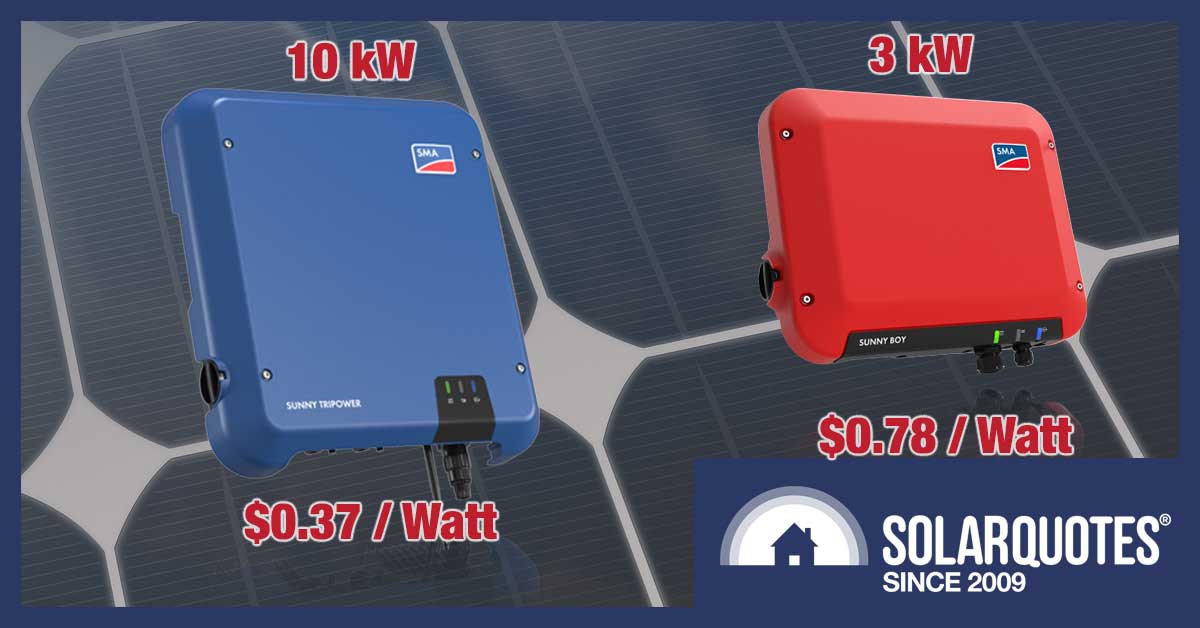
Big inverters are much cheaper per Watt. Another reason to go big with your solar power system.
When people ask me how much solar they should put on their roofs, I usually reply along the lines of…
“As much as you bloody well can.”
I’m not saying you should borrow money from the mafia or a dodgy finance company to do this. Still, I recommend putting on as many solar panels as is reasonable given the constraints of budget, roof space, and how much they’ll let you install in your area.
Larger Solar Systems Cost Less Per Watt Than Small Ones
Three reasons why Australian solar costs less per watt the bigger you go:
- Much of the labour stays the same, whether an installation is large or small.
- The STCs (aka solar rebate) is per panel and pays most of the actual panels’ wholesale cost.
- Most solar inverters get a lot cheaper per watt the bigger you go.
I will quickly explain why it’s a good idea to go big and why many labour costs stay the same, but the main focus of this article is how solar inverters get cheaper per watt as they go up in size.
The exception is microinverters, as their cost per watt remains the same regardless of system size.
I’ll also show what happens to the cost per watt for SolarEdge inverters, which are a special case as they require every solar panel has a SolarEdge optimiser. The cost per watt of SolarEdge systems falls with increasing size, but not quite as fast.
Mo’ Solar Mo’ Money
Here’s a good reason for having as many solar panels whacked on your roof as possible — money. If you have an unshaded roof, then paying a little more for a larger system may be the best investment you can make. Outside of Western Australia1 this is likely to be the case even if there is no one at home most days. This is thanks to the solar feed-in tariff you’ll receive for sending surplus solar energy into the grid.
Other Benefits Of Big Solar
Benefit #1 – It works better with batteries
While most home battery systems haven’t done a good job of lowering their prices, they will get cheaper. When that happens — if you want to regularly fully charge them through the winter and periods of cloudy weather — you’ll need a large solar power system. A bigger solar system will improve the return on your battery.
Benefit #2 – It works better with electric cars
The future of driving is electric. If you have money — trust me — you’re going to want an electric car soon if not now. If you don’t believe me, try out some of the sportier ones. If you don’t have a lot of money, given the cheap ones being built in China will rapidly improve, it may not be long before EVs are the lowest cost option for a new car. If you want to keep an electric car charged without blowing out your electricity bill then a large solar system is the way to go.
Benefit #3 – The more solar generation, the faster we can decarbonise
But the most important reason to go big on solar is environmental. I only recently realised it might not be many years before I become a grandfather, which has really impressed upon me the importance of keeping the planet in good nick. Even though, admittedly, it didn’t make nearly as much of an impression as my almost acquiring mastery of the dragon immortality stones.

I got this buff early in December, but seem to have put the weight back on over Christmas.
Recent analysis shows the fastest and cheapest way to get to 100% solar, wind and batteries is to ‘overbuild’ renewable generation. The magic number is about three times.
Bigger Solar Requires Little Extra Labour
When an installer puts solar on your roof, it’s not much harder to put on a 6.6 kilowatt system than a 3.3 kilowatt one. This is because the same amount of effort is required for the following:
- Sales
- System design
- Getting to and from the site
- Setting up and carting away any required safety gear
- Solar inverter and cabling installation
- Switchboard wiring
- Most after-sales support
The only major difference is the number of panels on the roof. Installing solar panels isn’t easy and putting on 20 is a hell of a lot harder than just 10, but it’s still far easier than installing two separate 3.3 kilowatt systems.
Bigger Inverters Require Little Extra Labour To Manufacture
Like a larger rooftop solar system, a larger solar inverter requires less effort to make per watt. A 2 kilowatt and a 5 kilowatt inverter both require about the same amount of labour to manufacture. While the bulk of the work is done by machines these days, it’s still an expense and building an inverter with twice the capacity requires considerably less than twice the “work”.
Also, the “brains” of the inverter — the control electronics — can be identical in function and cost between solar inverter sizes. This means the higher the inverter capacity, the lower the cost of these brainy components per watt.
Working Out Solar Inverter Price Per Watt
I’ve put the price per watt of several inverters into charts so you can see how it decreases with size. To get the price per watt, I used my nefarious connections to find the approximate wholesale price of an inverter, increased it by 20% to reflect the retail markup, and then added 10% GST. Then I divided it by the inverter’s capacity in watts.
Reality’s Price Per Watt May Be Different
Just because I give a particular price per watt for a solar inverter doesn’t mean you’ll be able to get one for that much. My method is just a consistent way to make an estimate. The actual price you’ll be offered in reality could be higher or lower, as the retail markup could differ considerably from the 20% figure I used. Also, even if my estimate was spot on, wholesale prices can change rapidly. While the overall trend is downward, they can rise in price if demand outstrips supply. Also, sudden swings in the value of the Australian dollar can instantly change prices in either direction.
Don’t Stress Over Component Pricing.
Some people get hung up on the price given for various components of solar power system quote they’ve received. But the exact cost of things such as the inverter, panels, racking, or the STCs that lower the cost of rooftop solar generally isn’t important. There are only two main things that are of vital importance to a homeowner getting solar:
- The final quoted price that has to be paid, and…
- Is the installer reputable and does good quality work?
If you’re happy with those two things, you should be fine.
Premium: SMA Inverters
Single Phase Sunny Boys
Many solar installers will tell you SMA is a manufacturer of high-quality solar inverters. And there are a few who won’t. To start with, I’m going to look at SMA’s Sunny Boy single-phase inverters.
The price per watt of a 6 kilowatt Sunny Boy is half that of a 1.5 kilowatt inverter. 1.5 kilowatt inverters are almost exclusively for replacing old ones that have failed.
If you are deciding between a 3 kilowatt or a 5 kilowatt inverter, the larger one is nearly one-third cheaper per watt:
SMA Tripower 3 Phase Inverters
There are only 6 Sunny Boy sizes, but SMA’s 3 phase Tripower inverters come in 10 different capacities. That’s a nice range, but only the smallest 6 are likely to be used for residential installation and, even then, a huge roof would be required for the 15 kilowatt Tripower inverter to make sense.
The graph below shows the 10 kilowatt Tripower is 26% cheaper per watt than the 5 kilowatt one. But if we compare the largest and smallest, the cost per watt of the humongous 110 kilowatt Tripower is 83% cheaper per watt than the 3 kilowatt Tripower:
While no one is likely to use a 110 kilowatt inverter for their home, the low cost per watt of big solar inverters shows why so many companies are installing large commercial solar systems. It’s generally the most cost-effective way for them to lower their energy bills.
A Line Graph For The SMA Tripower
To keep the graph Nazis happy and show how the cost falls per watt with a line, I made the graph below that shows the first 5 Tripower inverters with capacities that are multiples of 5 kilowatts. The solid blue line shows the actual price per watt, while the dotted one is a straight line drawn between those points:
Using the straight-line average for these 5 inverters, a 5 kilowatt increase in capacity reduces the price per watt by 18%. This is an impressive decrease.
Budget: Solis Inverters
Many consider SMA a premium inverter brand, and this is reflected in its price. This graphic from our Solar 101 Guide shows all the solar inverters we’re happy are reliable and well supported in Australia, with the more expensive ones to the right. As you can see, SMA lives in the high-end area of inverter graphic town:
Rather than look at the cost per watt of a similarly priced inverter such as Fronius, I decided to look at the cost per watt of an entry-level solar inverter likely to appeal to the budget-conscious. I decided to look at Solis rather than Goodwe simply because I came across its information first.
While I don’t expect a Solis inverter to last as long as a Fronius or SMA, I still think they are good value for what they cost, and I’d expect them to typically last beyond their 5 year warranty.
Solis 4G Single Phase Inverters
Here is a graph of the estimated price per watt of Solis 4G single-phase inverters:
Despite being roughly half the cost per watt of SMA Sunny Boy inverters, the proportional fall in the price per watt between 1.5 and 5 kilowatts are very similar at 47% lower for the Solis and 49% lower for the Sunny Boy. It appears both high and low-cost solar inverters follow the same general trend for declining cost per watt.
Solis 3 Phase Inverters
Solis 3 phase inverters have a slightly more dramatic drop in price per watt as their capacity increases than the SMA 3 phase inverters. Or at least they do until we get to the 25 kilowatt one, which heads up in price instead of down. What a pity… They were doing so well until that point! But despite the unexpected price increase, I will point out the 25 kilowatt Solis 3 phase inverter is still one third cheaper than the same sized SMA 3 phase inverter:
A Line Graph For Solis 3 Phase
Solis 3 phase inverters only come in multiples of 5 kilowatts. While this leaves people with fewer options, it does mean each bar on the graph above represents the same increase in capacity, which may be enough to keep me out of the clutches of the Graphstapo. But in case it isn’t, I’ve made a line graph of the information for those who appreciate this sort of thing:
If we look at the first four solar inverters then, on average, each 5 kilowatt increase in capacity drops the cost per watt by 18% — the same average as for SMA 3 phase inverters. But if we include the 25 kilowatt inverter, then the price decrease per watt only averages 13%.
SolarEdge
SolarEdge inverters are a special case because every panel has to have a SolarEdge optimizer2 for the system to work. These are little boxes of electronics that adjust the current so each solar panel will provide the maximum amount of power possible even when shaded.
They can eliminate some — and only some– of the losses caused by shade and dirt. But because they use a tiny bit of power themselves, some people — particularly one Danish person — says mildly shaded solar panels can be better off without them. Optimizers don’t consume much, and SolarEdge says theirs only eat 0.5% of the panels production. Since I don’t feel like getting into a fight over 0.5%, you’ll have to decide for yourself if they’re worth it for a mostly unshaded roof.
Unfortunately, like most things you buy, SolarEdge optimizers cost money. They retail for around $73 each and can be used on panels up to 370 watts. I’ll assume the average solar panel capacity it’s used with is 350 watts. This will add 21 cents to the cost of a SolarEdge system per watt of inverter capacity. That’s more than the entire cost per watt of a 4 kilowatt Solis single-phase inverter. As you can see, getting a system with an optimizer on every panel adds considerably to the cost.
For a 6.6 kilowatt solar power system, the cost of SolarEdge optimizers will add about $1,400 to the price. It is possible to get cheaper optimizers for non-SolarEdge systems that can be as little as 13 cents per watt ($850 for 6.6 kW). The good news is that most optimizers, including SolarEdge’s, have a 25 year warranty, so hopefully, they’ll last the system’s life without a problem.
It’s also possible to use Maxim integrated panels with built-in optimization for about 7c per watt extra, such as those manufactured by Suntech.
Solar Edge Inverters + Optimizers Price Per Watt
SolarEdge inverters come with an impressive 12 year warranty, and there are 5 single-phase ones available ranging from 3 kilowatts to 8 kilowatts. I could take inverter price per watt price and add the 21 cents per watt cost of their optimizers, but that would only work if the solar panel capacity were equal to the inverter capacity. For most installations, the panel capacity can be up to one-third larger. Because it’s normally a good idea to get as close to that limit as possible, I will assume for every watt of inverter capacity there will be 1.3 watts of solar panel capacity. This means the cost of SolarEdge optimizers per watt will be 27 cents per watt of inverter capacity.
Here’s the information, put into a chart:
As you can see, the optimizers make up a big chunk of a SolarEdge system’s cost. With a 5 kilowatt inverter, they are almost half the cost, and for an 8 kilowatt inverter, they’re a little over half.
While the total cost per watt a SolarEdge inverter plus optimizers does fall as the solar inverter size increases, the drop isn’t as dramatic as with the SMA and Solis inverters. On the other hand, the SolarEdge system will have the advantage of optimizers, so it’s not as if we are comparing the same thing.
If we look at the cost of the SolarEdge inverters without optimizers then going from 3 kilowatts to 6 kilowatts drops the price per watt by one-third, which is the same for SMA inverters and much the same as going from a 2 kilowatt to a 4 kilowatt Solis inverter.
Enphase Microinverters
I’m way too lazy to make a graph for every standard inverter on the market, but you can trust me when I tell you they all have a strong tendency for their cost per watt to fall with increasing size. (Lazy people are very trustworthy.) But there is a type of solar inverter to which this doesn’t apply.
Microinverters are tiny inverters, and each solar panel gets one3. This is pretty neat because it lets each panel act on its own independently and the overall effect on generation is similar to having an optimizer on each solar panel.
But microinverters don’t help decrease the cost of a solar system as it gets larger. This is because the cost per unit is the same whether you use 1 or 100. If you get a system with microinverters installed these days you can be pretty damn sure they’ll be either Enphase IQ 7 or the newer Enphase IQ 7+. My estimated cost per watt of the Enphase IQ 7+ is 59 cents, with the IQ 7 being slightly higher.
There’s no point in making a graph showing how microinverter cost per watt changes with capacity because it doesn’t. With Enphase it’s always going to be 59 cents per watt4 whether you want one kilowatt or one hundred.
Microinverters Make Sense For Quality Small Systems
If you are happy to pay for a top-end solar inverter and your roof has no significant shading issues then Enphase microinverters are likely to be a good choice for solar power systems with a total inverter capacity of under 3 kilowatts. That’s under 4 kilowatts of solar panel capacity.
If your roof has shade issues, or you like the idea of having optimized panels, then you may want to consider microinverters if the total solar panel capacity is under 5 kilowatts and the panel capacity is around 6 kilowatts or less.
If you are on a tight budget and want a low-cost system, then, unless there are special circumstances, you will probably never want to use microinverters. A low-cost inverter such as a Solis or a Goodwe will be cheaper, with or without optimizers.
The Finale
I’ve shown how solar inverters decline in price per watt with increasing capacity at an impressive clip and applies to both top end and entry-level inverters. To conclude, I could repeat myself and once again explain how this contributes to making filling your roof with solar a good idea — or I could write a song about it.
Being the fantabulous person I am, I have, of course, decided to end with a musical finale. I have blown the budget and commissioned a talented fellow to record, just for you, a special performance of my ode to large solar systems.
Ladies and gentlemen, I present ‘Go Big’ (with apologies to The Village People).
(Go bigger) It’s the only way,
(Go bigger) It will likely pay.
(Go bigger) Go and fill your roof,
(Go bigger) Ronald gave the proof,
(Go bigger) Power bills won’t be so high,
(Go bigger) More power from the sky,
(Go bigger) Cut CO2 emission,
(Go bigger) This is your mission.
(Go big) Solar shows you care,(Go big) In the open air,
(Go big) Where the skies are blue,
(Go big) This is what we’re gonna do,
Go big, this is what we’re gonna do, go biiiiiiiigggggg…
Footnotes
- While the feed-in tariff for new solar in WA is very low, if people are usually at home during the day or an effort is made to shift consumption to the day, it can still definitely pay to get the biggest solar system normally installed in WA, which is 6.6 kilowatts. ↩
- SolarEdge spells the word “optimizer” with a “z” rather than “optimiser” with an “s”. Because I’ve never met anyone yet who pronounces the word as “opti-mis-er” I’m fine with SolarEdge’s spelling. ↩
- I know there are exceptions where one is shared between two panels or even four, but these days a residential microinverter installation is pretty much certain to have one per panel. ↩
- Plus the cost of an Envoy communications hub ↩

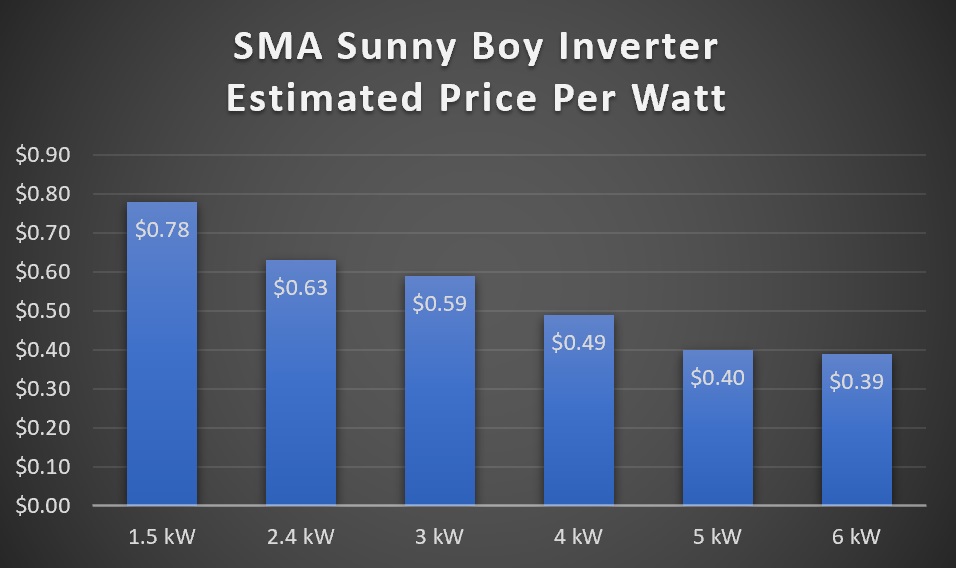
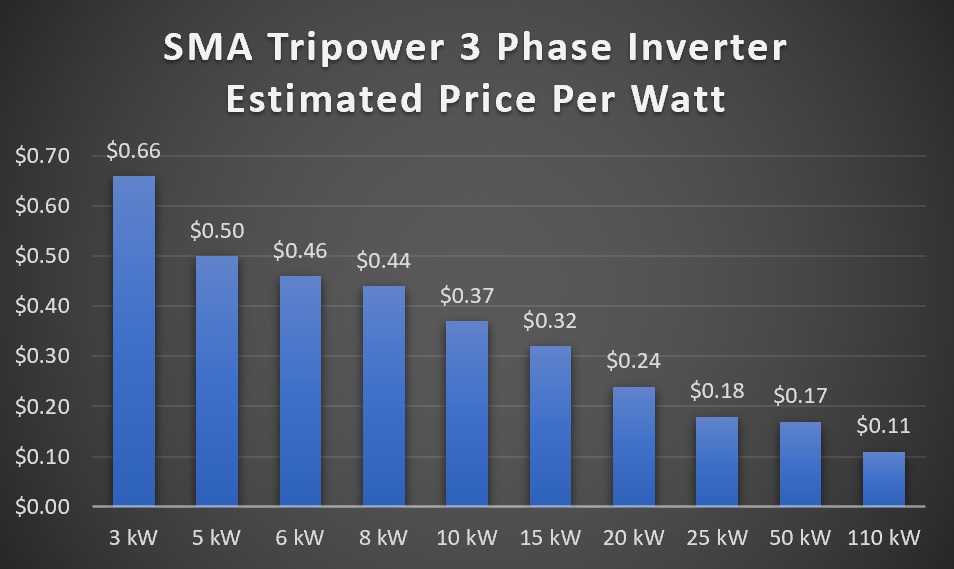
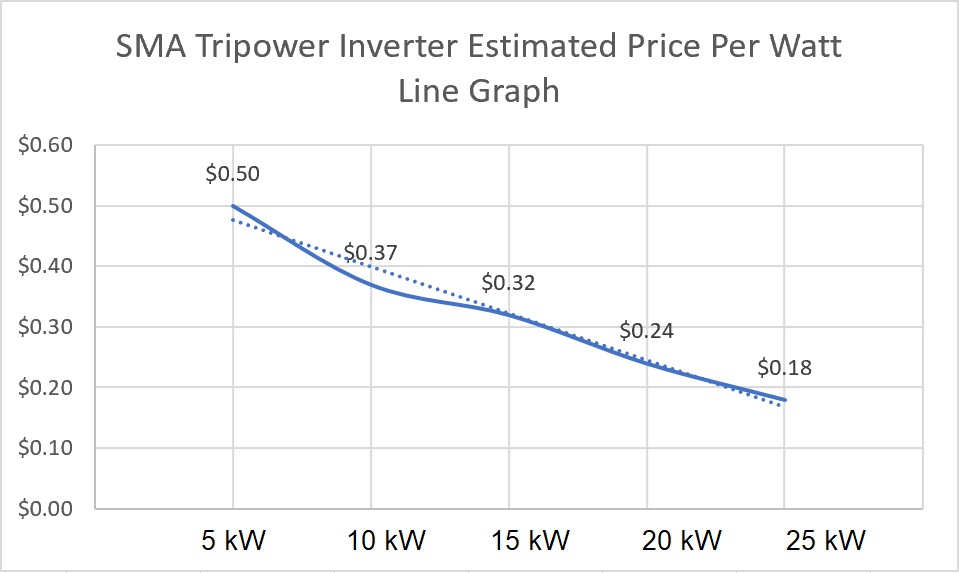
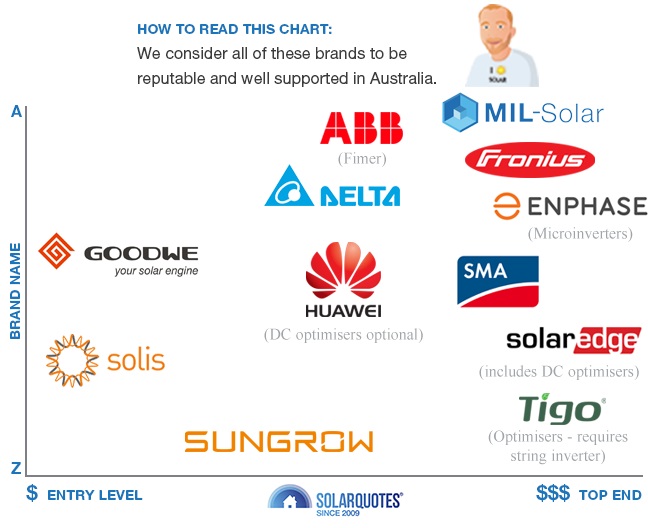
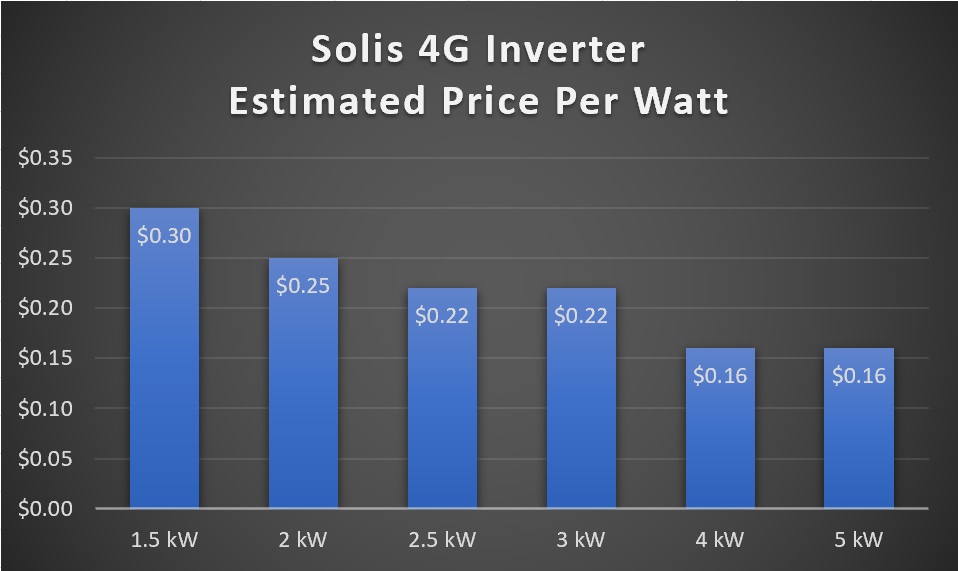
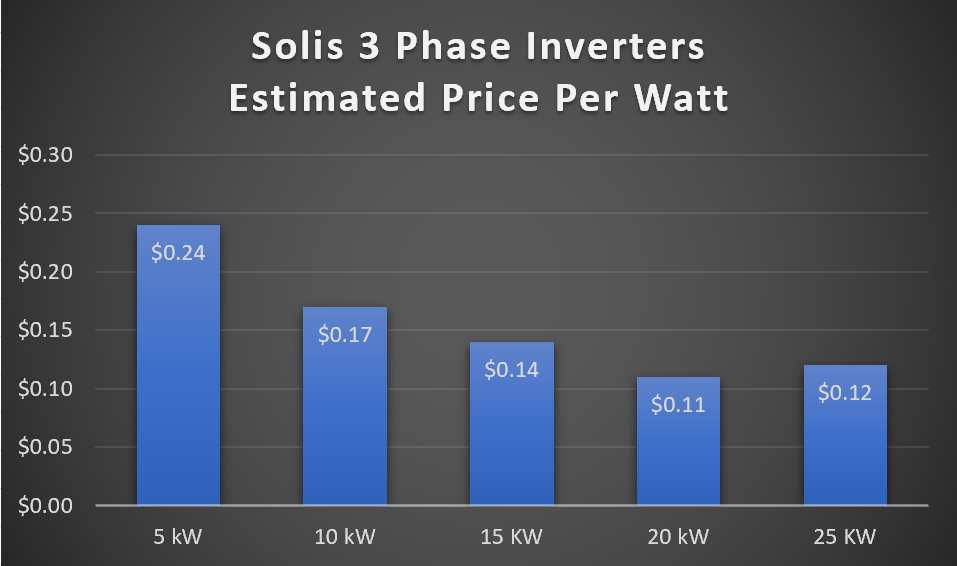
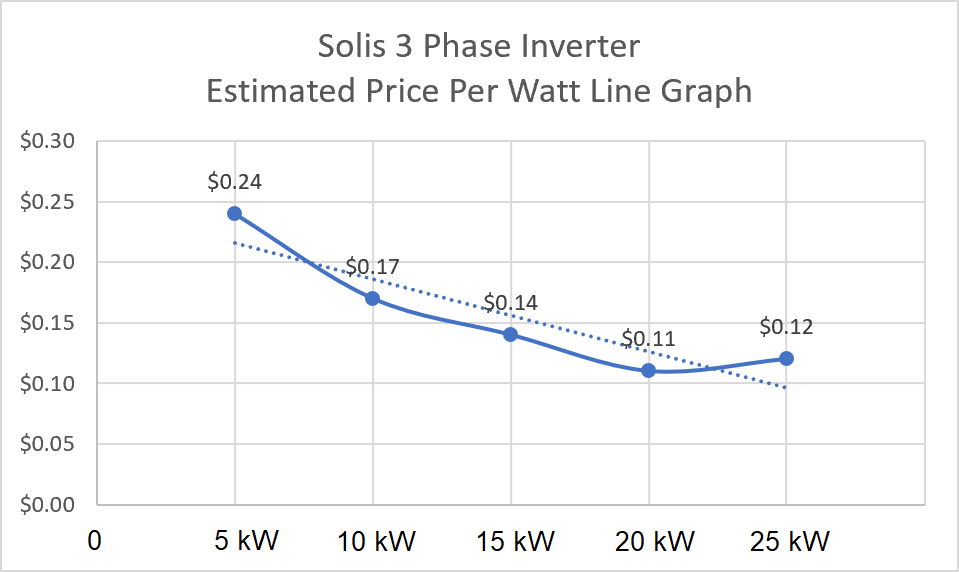
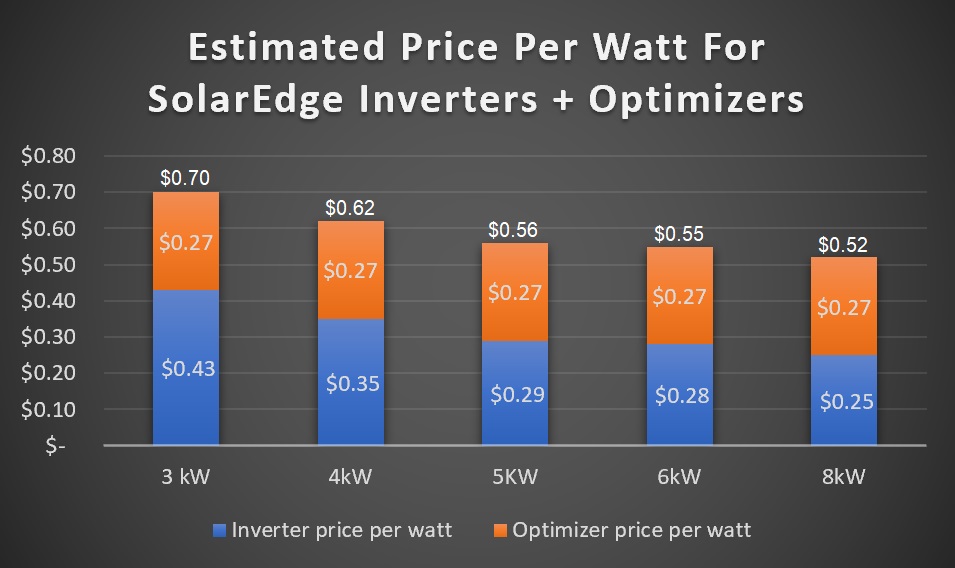
 RSS - Posts
RSS - Posts



Great article- however you didn’t mention the benefits from having less array oversizing (larger inverter) to deal with the Volt-Var response mode at peak production with less lost energy absorbing Vars. Excess inverter capacity with Australia’s poorly regulated line voltages is a very useful thing. Maybe a follow-up piece?
panels are now cheaper per watt than the inverter plus mounting, a good time to pay attention to the inverters, next time mounting ?
I suspect that some manufacturers are now doing what the Medical Electronics industry does, in that they make a single item, then software configure the specs (so it could be that the 3Kw inverter is the same as the 5 or 7.5Kw, but is software limited to 3Kw. It is cheaper for the manufacturer to make less on the low end, but not have bigger inventories. I have heard instances of someone complaining their 5Kw inverter was only producing 4Kw max, but after the manuf agent reloaded the firmware, the output went to the correct 5Kw.
This begs the question that we may be able to have our inverters ´upgraded´ if we need more output so fit more panels. (Of course only if it is one of these models….)
regards, Doug
The song at the end It’s an excelent touch
With the title of the above article, and its content, and, the published response to my question relating to another article in the blog (about overloading inverters, or export limiting, I think), about the limit on the STC’s that may be claimed, it is unfortunate, that STC’s are not payable for the full solar panels generating capacity of allowed inverters.
An example of this, is the example that I cited in that query; the Goodwe GW5000-MS, with its limit of A/C power produced, of 5kW, whilst allowing for an overload factor of two; allowing for total solar panels generating capacity of 10kW, which would be good for days when less solar energy is available for conversion to electricity.
And, I understand that that inverter costs only $300 more than the Goodwe GW5000D-NS (which we have).
But then, I suppose, it could still be worth getting a GW5000-MS, for its 3 MPPT’s functionality, connected to the currently STC’s eligible limit of 6.5 (or 6.6?) kW of panels generating capacity, in the hope that someday, we will get a federal parliament that will provide STC’s for the whole of the maximum panels generating capacity of allowed inverters.
We could hope…
I think one major thing you forgot to mention is the Victorian Government Rebate (for people in Victoria). As it is a fixed amount of $1850, regardless of the size of the system, wouldn’t it make more sense to install a smaller system in some cases as they would be significantly cheaper after this rebate?
Bigger is better, however some providers have limited inverters to 5kw.. they’ve also started having inverters limited from exporting to the grid. Friends will have solar but no cash back on their bills..
I think it depends a lot on your usage. Most people I know say smaller is better because the rebate amount is fixed, regardless of the size of the solar system, so with smaller systems, it is not rare for the Victorian government rebate to cover nearly half the cost of the system.
For example, I recently got a quote for a 6.6KW system and it was $2350 after the rebate – good luck finding a larger system for $356 out of pocket per KW – and I’m sure if I got a smaller system, the price would be even cheaper per KW.
Another reason for getting a smaller system is that the feed in tariffs have been reducing for years and are likely to continue to do so – and the smaller the system, the higher the percentage of the power produced will be getting used instead of it feeding back into the grid for next to nothing.
Wendy – if you consider both a system like the one described at
https://www.deepcyclesystems.com.au/hybrid-solar-package-7-44kwh/
except, with the BMS and the inverter, both replaced with something like the Goodwe GW5048D-ES inverter, with does the jobs of both, and, with the panels capacity reduced to 6.6kW, and, if you consider the provision at
https://energysaver.nsw.gov.au/households/solar-and-battery-power/empowering-homes-solar-battery-loan-offer ;
”
Through this offer, you can get an interest-free loan of up to:
$14,000 towards a solar PV and battery system (repayable over a range of terms up to 8 years)
”
with the interest-free loan needing to be increased to up to $20,000, and the repayment period needing to be increased to up to ten years, then, the combination of the system and the interest-free finance (providing it is also no deposit and, with no charges for the financing), it should take care of the issue of export bans, and, should be almost the ideal solution for most detached houses in Australia.
It is “simply” a matter of campaigning for the state/territory governments to provide the appropriate finance to householders.
If you get a battery with the solar system, then I can see a decent argument for “bigger is better” as it means you might be able to go off the grid entirely and avoid the supply charge.
In my case, my electricity bill is only around $50-60 a month (without solar panels) and my average daily usage is around 2.8kWh, so even if I got a $14k system and went off the grid, it would take me 23 years to break even – far beyond the useful life of the battery.
I understand that almost all households use a lot more electricity than me though, so that sort of system is probably worth it to most people given the appropriate financing (as you mentioned) as long as they plan to live in the same house for long enough.
Going off-grid to avoid the daily service charge is almost always a false economy. Financially, it will almost always make more sense to remain on-grid and receive a feed-in tariff and the environmental benefit of sending clean energy into the grid is huge. But I can understand people in Western Australia considering it since the feed-in tariff there for new solar is now so low. (It may average less than 4 cents per kilowatt-hour.)
Hi Finn,
The problem i have with going BIIIG is that to do that I need a triple MPPT inverter EAST/NORTH/WEST. Do any exist?
I can fit about 5.4k/w on NORTH/WESTbut east could easily bump that up by another third.
There are residential inverters available with three MPPT available. Goodwe is an example of an inverter manufacturer that produces them. With a flexible inverter such as a Fronius it is also possible to have solar panels facing in three directions with only two MPPTs under the right circumstances.
If you are wondering, what you specifically need for three directions with two MPPTs is an inverter that can take enough current to support two parallel strings of solar panels (such as Fronius).
This lets you hook up two parallel strings to the same MPPT input and so long as both strings have the exact same number and model of panels and there is no shade then the optimum operating voltage of each string will be close enough that the losses from operating on the same MPPT are insignificant (possibly less than 1%). It works because the optimum voltage doesn’t actually vary much at different illuminations, but the optimal current does and arranging the panels in this way allows the different orientations to operate at the same voltage, but different currents which can be pretty close to optimal for both of them at the same time.
It is still probably far easier to just use an inverter with three inputs or stick with a slightly smaller system and only two directions, but it is possible in the right circumstances.
More information is available at https://www.solarquotes.com.au/blog/an-eastwest-spit-of-solar-panels-on-a-single-string-can-work-well/.
The internal resistance of inverters vs inverter size may also be a consideration when considering inverter output at marginal generating times of the day & the total lifetime output of the solar system.
While “Go big or go home” seems to be the usual advice when it comes to solar PV, I can’t help thinking systems should still be right sized for the home’s actual and expected energy consumption and consumption patterns.
Given a large number of homes will self-consume only a minority of their solar PV output (circa 20%) and with FITs still on the decline there must come a time when going big isn’t so attractive.
Also higher FITs are typically restricted to smaller PV systems.
Have a look at the high FIT solar plans of electricity retailers. All the high FIT plans have limits on system size, usually need to be under 10kW (peak panel capacity). Or they have a stepped FIT schema with FIT reducing after a set number of kWh exported per month.
If you have a large PV system, high FITs are a thing of the past.
A 10kW system costing $10k generating ~140,000kWh over 10 years works out to be roughly 7c/kWh (paid up front). Yes it’ll probably last a bit longer than that but not everyone will be in their home for that long.
Given FITs are now trending towards ~8c/kWh, and will probably will go lower (albeit not to zero), if your home’s PV self-consumption ratio is low, then significantly oversizing may not be all that sensible unless you have a way to also significantly increase your self-consumption ratio.
The incremental cost of the extra panels tends to be lower though, so if 10kw costs $10k compared to 6kw for $8k for example then you are getting an extra 4kw for $2k which is only 3.5c per kWh over 10 years. A FIT of 7c per kWh is plenty to justify that even with no self-consumption (and while self consumption of the extra will be low, there will always be some extra self consumption).
Costs will obviously vary depending on lots of factors, but if you are going to use your logic then you should be looking at the cost per kWh based on the extra cost of the larger system, whatever that is in your scenario, rather than the overall cost per kWh.
Errr, just wondering why Victron and Selectronic, both local brands selling nationwide, are missing?
My brother has two 5 kW Victrons in his new 4-inverter 19 kW array + 10 kWh battery installation, and I’m looking at one bigger Selectronic battery inverter and a PV inverter.
Dropping to one battery inverter and one PV inverter, from two of each, loses redundancy, i.e. fault tolerance. So the 4-inverter installation is more robust in an off-grid situation, I figure. But there’s always the generator.